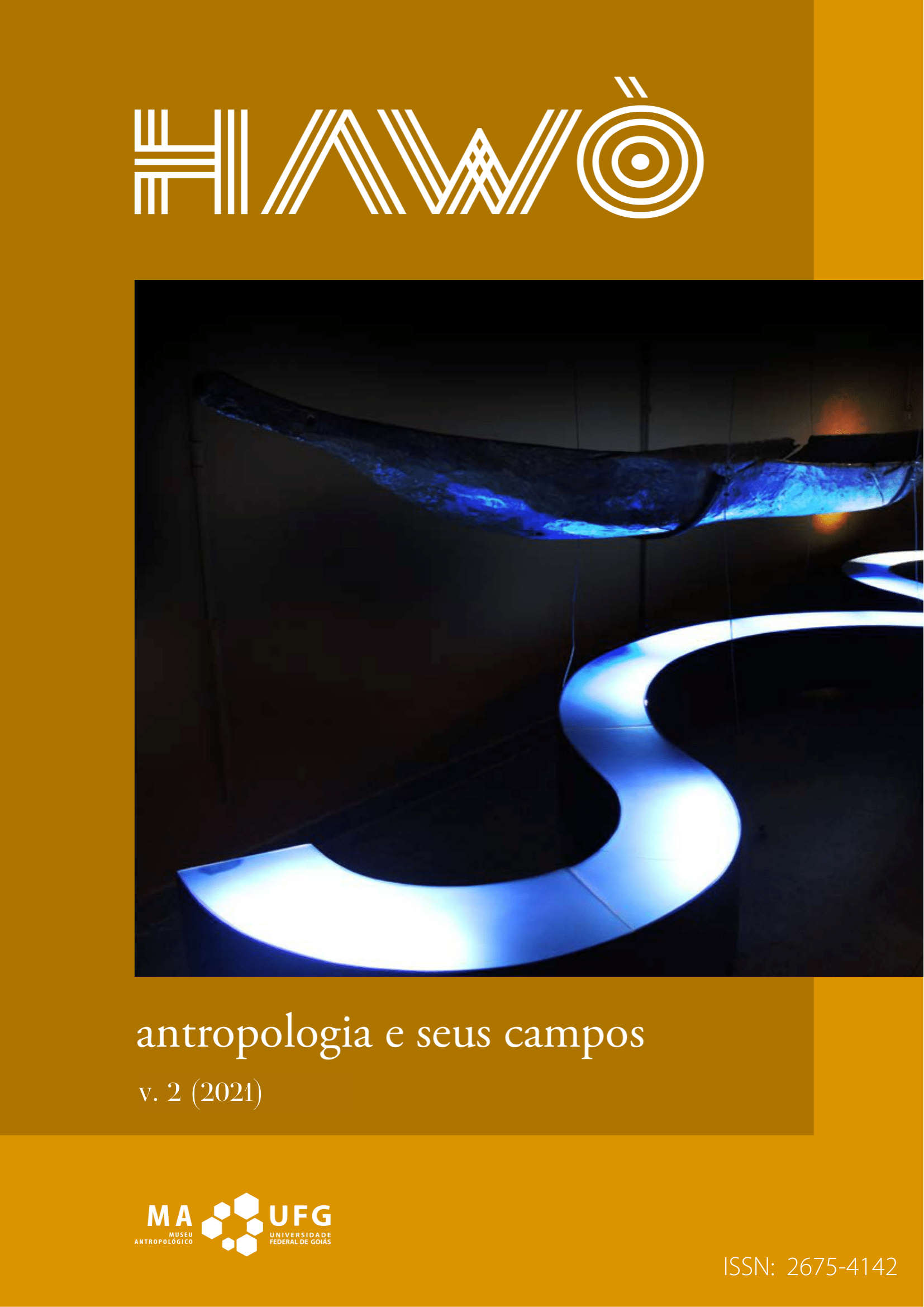Landscape Archaeology
Keywords:
Archaeology. Anthropology. History. Landscape.Abstract
The historical trajectory of the concept of landscape - within Archeology - is recapitulated from the beginning of the discipline in
the 19th century to the most current approaches, including historicalculturalism and processualism. The diversity of applications of the concept of Landscape in Archeology is presented in a series of concrete examples that include the funerary monumentality of the ‘sambaquis’ of southern Brazil; earthworks and as ‘Landscapes of Movements’ in the Llanos de Morros in Bolivia; the sacredness of the landscape and the concept of Huaca among Andean societies; suspended terraces for agriculture in Guyana; the debate on the carrying capacity of Amazonian biomes and pre- colonial forest management; the pan-Amazonian 'geoglyphs' and the Bückberg hill in Germany, where the Nazi Third Reich ‘harvest festival’ was held.
References
ANSCHUETZ, K. F.; WILSHUSEN, R. H.; SCHEICK, C. L. An archaeology of landscapes: perspectives and directions. Journal of Archaeological research, v. 9, n. 2, p. 157-211, 2001.
BALÉE, W.; ERICKSON, C. Time and complexity in historical ecology: studies in the neotropical lowlands. Columbia University Press, 2006.
BECK,L. A. Regional approaches to mortuary analysis. Springer Science & Business Media, 2013.
BINFORD, L. R. Mortuary practices: their study and their potential. Society for American Archaeology, Washington, DC, p.6-29, 1970.
BINFORD,L. R. The archaeology of place. Journal of Anthropological Archaeology, v.1, p. 5-31, 1982.
BOURDIEU,P. Outline of a theory of practice. Cambridge: Cambridge University Press, 1977.
BURSTRÖM, M.; GELDERBLOM,B. Dealing with difficult heritage: The case of Bückeberg, site of the third reich harvest festival. Journal of Social Archaeology, v.11, p. 266-282, 2011.
BUTZER, K. W.Archaeology as human ecology. Cambridge: Cambridge University Press, 1982.
CHILDE, V. G. The dawn of European civilization. Kegan Paul, London, 1925.
DAVID, B.; THOMAS, J. Landscape Archaeology: introduction. In:- DAVID,B.;THOMAS,J. (eds.).Handbook of Landscape Archaeology. London: Routledge, 1998. p. 27-43.
DEBLASIS, P.; KNEIP, A.; SCHEEL-YBERT, R.; GASPAR, M. D. Sambaqui e paisagem: dinâmica natural e arqueologia regional no litoral do sul do Brasil. Arqueologia Suramericana, v.3, p. 29-61, 2007.
DUNNELL, R. C. The notion of site. In: DUNNELL, R. C. Space, time, and archaeological landscapes. Boston: Springer, 1992. p. 21-41.
FAGUNDES, M.; PIUZANA, D. Estudo teórico sobre o uso conceito de paisagem em pesquisas arqueológicas. Revista Latinoamericana de Ciencias Sociales, Niñez y Juventud, v.8, p. 205-220, 2010.
GIANOTTI, C.; BONOMO, M. De montículos a paisajes: processo de transformación y construcción de paisajes en el sur de la cuenca del Plata. Comechingonia Revista de Arqueología, p. 129-163, 2013.
GOLDSTEIN,L. G. Spatial structure and social organization: regional manifestations of Mississippian society. 1976. Dissertation (Unpublished Ph.D.) - Northwestern University, Evanston, Illinois, 1976.
HECKENBERGER, Michael. The ecology of power: culture, place, and personhood in the southern Amazon, AD 1000-2000. Psychology Press, 2005.
HECKENBERGER,M.; NEVES,E. G. Amazonian Archaeology. Annual Review of Anthropology, v.38, p. 251-266, 2009.
HECKENBERGER, M. J.; RUSSELL,J. C.; TONEY,J. R.; SCHMIDT, M. J. The legacy of cultural landscapes in the Brazilian Amazon: Implications for biodiversity. Philosophical Transactions of the Royal Society B: Biological Sciences, v. 362, p. 197-208, 2007.
HODDER,I. (ed.).The spatial organization of culture. Pittsburgh: University of Pittsburgh Press, 1978.
INGOLD, T. The temporality of the landscape. World Archaeology, v.25, p. 152-174, 1993.
MARSHALL, A. J. Environment and agriculture during the Iron Age: statistical analysis of changing settlement ecology. World Archaeology, v. 9, p. 347-356, 1978.
MEGGERS,B.J. Environmental limitation on the development of culture. American Anthropologist, v.56, p. 801-824, 1954.
MEGGERS,B. J. The continuing quest for El Dorado: Round two. Latin American Antiquity, v. 12, p. 304-325, 2001.
MENESES,U. T. B. A paisagem como fato cultural. In: SERPA, A.; NUNES, C.; SANDEVILLE JR. E.et al.(eds.).Turismo e Paisagem. São
Paulo: Contexto, 2002. p. 29-64.
MORAES,C. P.; NEVES,E. G. O ano 1000: adensamento populacional, interação e conflito na Amazônia Central. Amazônica, v. 4, p.
-148, 2012.
MORAIS, J. L. Tópicos de arqueologia da paisagem. Revista do Museu de Arqueologia e Etnologia, São Paulo, n.10, p. 3-30,
PELLINI, J. R. Onde está o gato? Realidade, arqueologia sensorial e paisagem. Habitus, Goiânia, v.9, n. 1, p. 17-31, 2011.
PUGLIESI, F. A.; VALLE, R. B. M. A gestão do patrimônio arqueológico em territórios indígenas: a resistência Munduruku e a preservação do patrimônio cultural frente aos territórios tradicionalmente ocupados. Revista de Arqueologia, São Paulo, v. 28, n. 1,
p. 30-51, 2015.
ROOSEVELT,A. C. The Amazon and the Anthropocene: 13,000 years of human influence in a tropical rainforest. Anthropocene [on-line], v. 4, p. 69-87, 2013.
SALAZAR, E. Pre-Columbian mound complexes in the Upano River Valley, Lowland Ecuador. In: SILVERMAN, H.; ISBELL,W. H. (eds.). Handbook of South American Archaeology. New York: Springer, 2008. p. 263-278.
SALDANHA, J. D. M.; CABRAL, M. P. Potes e pedras: uma gramática de monumentos megalíticos e lugares naturais na costa norte do
Amapá. Revista de Arqueologia, v.25, p. 48-57, 2012.
SAXE, A. A. Social dimensions of mortuary practices in a Mesolithic population from Wadi Haifa, Sudan. Memoirs of the Society for American Archaeology, v.25, n. 1, p. 39-57, 1971.
SCHMIDT, M. J.; RAPP PY-DANIEL, A.; PAULA MORAES, C. et al.Dark earths and the human built landscape in Amazonia: a widespread
pattern of anthrosol formation. Journal of Archaeological Science, v.42, p. 152-165, 2014.
SILVA, F. A. Arqueologia colaborativa com os Asurini do Xingu: um relato sobre a pesquisa no igarapé Piranhaquara, T. I. Koatinemo.
Revista de Antropologia,S ão Paulo, v.58, n. 2, p. 143-172, 2015.
SNEAD, J. E.; ERICKSON,C. L.; DARLING, J. A. Landscapes of movement: trails, paths, and roads in anthropological perspective. Philadelphia: University of Pennsylvania Museum of Archaeology and Anthropology, 2009.
SOUZA, R. A. Arqueologia e a guerrilha do Araguaia ou a materialidade contra a não narrativa. Revista de Arqueologia Pública, Campinas, v. 10, n. 1, p. 1-19, 2014.
STAGER, L. E.; HURST, H. A metropolitan landscape: the late Punic port of Carthage. World Archaeology, v. 9, n. 3, p. 334-346, 1978.
STJERNQUIST, B. Approaches to settlement archaeology in Sweden. World Archaeology, v. 9, n. 3, p. 251-264, 1978.
STRAUSS, A. Possibilidades e limitações interpretativas da Hipótese Saxe/Goldstein. Boletim do Museu Paraense Emílio Goeldi Ciências Humanas, Belém, v.7, n. 2, p. 525-546, maio-ago. 2012.
TER STEEGE H.; PITMAN, N. C. A.; SABATIER, D.et al. Hyperdominance in the Amazonian Tree Flora. Science, v. 342, n. 6156, Oct. 2013.
TILLEY,C. A phenomenology of landscape places, paths and monuments. Oxford: Berg Publisher, 1994.
TRIGGER, B. G. História do Pensamento Arqueológico. 2. ed. São Paulo: Odysseus, 2011.
WATLING, J.; et al. Impact of pre-Columbian “geoglyph” builders on Amazonian forests. Proceedings of the National Academy of
Sciences, v. 114, n. 8, p. 1868-1873, 2017.
WILLEY, G. R. Prehistoric settlement patterns in the Virú; Valley, Peru. Bureau of American Ethnology Bulletin, v.155, p. 1-453, 1953.
WÜST, I., BARRETO, C. The ring villages of central Brazil: a challenge for Amazonian archaeology. Latin American Antiquity, p. 3-23, 1999.
ZARANKIN, A.; PELLINI, J. R. Arqueologia e companhia: reflexões sobre a introdução de uma lógica de mercado na prática arqueológica brasileira. Revista de Arqueologia, São Paulo, v.25, p. 44- 60, 2012.
ZEDEÑO, M. N. Landscapes, Land Use, and the History of Territory Formation: An Example from the Puebloan Southwest. Journal of Archaeological Method and Theory, v. 4, p. 67-103, 1997.
Downloads
Published
Versions
- 2022-03-30 (2)
- 2022-03-09 (1)
How to Cite
Issue
Section
License
Copyright (c) 2022 André Strauss

This work is licensed under a Creative Commons Attribution 4.0 International License.
Os(as) autor(es/as) que publicam na Revista Hawò são os responsáveis pelo conteúdo dos artigos assinados e detém os direitos autorais. Concedem à revista, o direito de primeira publicação com o trabalho simultaneamente licenciado sob a Licença Creative Commons Atribuição-Não Comercial (Open Archives Iniciative - OAI). Esse recurso, utilizado para periódicos de acesso aberto, permite o compartilhamento do trabalho para fins não comerciais com reconhecimento da autoria. Caso o texto venha a ser publicado posteriormente em outro veículo, o autor deverá informar que o mesmo foi originalmente publicado como artigo na revista Hawò. Assim sendo, ainda que a revista seja detentora da primeira publicação, é reservado aos autores o direito de publicar seus trabalhos em repositórios institucionais ou em suas páginas pessoais, mesmo que o processo editorial não tenha sido finalizado.
É reservado à revista, o direito de realizar alterações de ordem normativa, ortográfica e gramatical visando manter o padrão de língua, respeitando-se, porém, o estilo dos autores.







